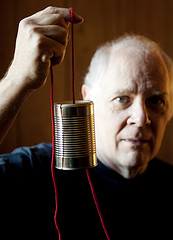Each semester Dr. Gary Thorne pulls out a simple visual aid to help his student understand his view of the learning process. It’s an ordinary can with a string: “The can is a useful way to illustrate the idea that we learn from our own efforts. A teacher can’t shove information into his or her students; the students have to pull it in. That means that they have to work. It also means that a big part of the instructor’s job is to create educationally useful work for them to do.”
A psychology professor with a background in the Air Force, Gary is fascinated by how we learn and, more importantly, solve problems. In the classroom, he tries to help students appreciate the basic principles of science which are, in his opinion, overly complicated in most research textbooks. His goal is to give students an appreciation of the scientific method and the ability to see the world both creatively and realistically. Many of his students continue in graduate school but Gary thinks that these are skills they can use in almost any endeavor.
“In any activity you are testing effects, seeing what works and what doesn’t work, making adjustments, and finding new problems. Science is messy, creative work that is loaded with uncertainty. We seldom know exactly how to do an experiment or what the results will be. We grope our way to answers one uncertain step after another. This is not the way it seems when we watch a movie, read a journal article, or even read a book on research methods. Everything is tidied up so that the messiness doesn’t show—but it’s always there. I try my best to show students that in the classroom and when we work on experiments.”
Right now, Gary is working with two several undergraduate research assistants and fellow professor Anna Marie Medina to try and get a better understanding of how we solve problems. Specifically, he wants to know if switching between tasks improves problem solving ability, a hypothesis based on personal experience debugging computer programs. “I learned that, after a certain point, working more didn’t help. I needed to take a break and then, later, pull it out of my bag on the train. Then, the solution would jump out at me,” he says.
According to Gary, taking a break or “spacing” has been observed by many psychologists as helping improve memory. The classic example: taking a break between study sessions will improve memory for what is being studied. Gary’s interest is in what happens when you switch between different kinds of tasks involving linguistic, visual, and kinesthetic problems. So far, there has been previous research on breaks and problem-solving but the results tend to be inconsistent, which has encouraged him to conduct his own experiments.
Meanwhile, Professor Thorne’s advice for working on tough and creative problems? Take the relaxed approach: “Don’t work too hard or for very long but work regularly.” This might seem counter to the culture in many of our organizations, he says, but seems to be the best way to get the fastest results. And, of course, he says, once you’ve solved one problem there is still another problem and a lot more work to do!
